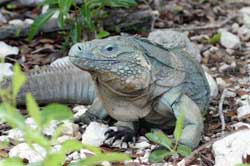Grand Cayman blue iguana: Back from the brink of extinction

This is an adult Grand Cayman blue iguana on its namesake island. Decimated by a combination of habitat destruction, car-related mortality, and predation by introduced cats and dogs, the reptile numbered between 10-25 individuals by 2002. A recovery program -- assisted by health experts from the Bronx Zoo -- has brought the number of free-ranging iguanas within Grand Cayman's protected areas to more than 500 animals. Credit: Julie Larsen Maher/Wildlife Conservation Society
While thousands of species are threatened with extinction around the globe, efforts to save the Grand Cayman blue iguana represent a rarity in conservation: a chance for complete recovery, according to health experts from the Wildlife Conservation Society's Bronx Zoo and other members of the Blue Iguana Recovery Program.
Coordinated by the National Trust for the Cayman Islands, the Blue Iguana Recovery Program—a consortium of local and international partners—has successfully released more than 500 captive-bred reptiles since the initiative's inception in 2002, when the wild population of iguanas numbered less than two dozen.
“For the past several years, we've succeeded in adding hundreds of animals to the wild population, all of which receive a health screening before release,” said Dr. Paul Calle, Director of Zoological Health for WCS's Bronx Zoo.
Fred Burton, Director of the Blue Iguana Recovery Program, said: “We expect to reach our goal of 1,000 iguanas in managed protected areas in the wild in a few years. After that, we will monitor the iguanas to make sure they are reproducing in the numbers needed to maintain the wild population. If we get positive results, we will have succeeded.”
The Grand Cayman blue iguana is the largest native species of its namesake island, growing to more than 5 feet in length and sometimes weighing more than 25 pounds. The iguana formerly ranged over most of the island's coastal areas and the dry shrub lands of the interior before becoming endangered by a combination of habitat destruction, car-related mortality, and predation by introduced dogs and cats. The entire island's wild population in 2002 was estimated at only 10-25 individuals.
Recovery efforts to save the Grand Cayman blue iguana have mostly centered on the Salina Reserve, a 625-acre nature reserve located on the eastern side of the island. After being hatched and raised for a year or two in a captive breeding facility, each iguana receives a complete health assessment before release. This involves veterinarians taking blood and fecal samples for analysis, as well as weighing and tagging each reptile. The samples are analyzed in a nearby lab at the St. Matthews Veterinary School while sampling continues. The iguanas are released after the lab results are reviewed and health is verified. This year, the recovery program is releasing iguanas into a new protected area, the Colliers Wilderness Reserve, established last year and managed by the National Trust.
Media Contact
More Information:
http://www.wcs.orgAll latest news from the category: Ecology, The Environment and Conservation
This complex theme deals primarily with interactions between organisms and the environmental factors that impact them, but to a greater extent between individual inanimate environmental factors.
innovations-report offers informative reports and articles on topics such as climate protection, landscape conservation, ecological systems, wildlife and nature parks and ecosystem efficiency and balance.
Newest articles

Superradiant atoms could push the boundaries of how precisely time can be measured
Superradiant atoms can help us measure time more precisely than ever. In a new study, researchers from the University of Copenhagen present a new method for measuring the time interval,…

Ion thermoelectric conversion devices for near room temperature
The electrode sheet of the thermoelectric device consists of ionic hydrogel, which is sandwiched between the electrodes to form, and the Prussian blue on the electrode undergoes a redox reaction…

Zap Energy achieves 37-million-degree temperatures in a compact device
New publication reports record electron temperatures for a small-scale, sheared-flow-stabilized Z-pinch fusion device. In the nine decades since humans first produced fusion reactions, only a few fusion technologies have demonstrated…





















